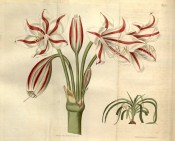Crinum zeylanicum L.
Frost-tender, deciduous, bulbous perennial with a large bulb, to 20cm diameter, up to 10, thin, erect or spreading, sword-shaped leaves, sometimes with undulating edges, and flower stems, to 90cm long, bearing up to 20, fragrant white flowers, with a broad violet-crimson keel, in spring. To 90cm. [RHSD, Hortus].
Horticultural & Botanical History
The relationship of morphologically very similar Crinums from tropical Africa, the Americas and Asia has been dividing botanists since the time of Linnaeus. In the Hortus it is assumed that Crinum scabrum Herb. and Crinum zeylanicum L., are synonymous, a view not held by all taxonomists. Plants relevant to the Hortus, Crinum scabrum and Crinum ornatum are therefore considered to be forms of Crinum zeylanicum L. Most importantly for the history of the Camden Park gardens only the plant identified by William Macarthur as Crinum scabrum was grown for any length of time and this was the only plant of this group apparently used for hybridising. See also Crinum zeylanicum L. var. ornatum.
First botanically described as Amaryllis zeylanica by Linnaeus in 1753 [Sp. Pl. p.293/1753]. Linnaeus himself reclassified this plant as Crinum zeylanicum in 1767 [Syst Nat. ed.12, vol.2, p236/1767]. William Herbert identified his plant from tropical America as Crinum scabrum in 1820: ‘The original bulb was imported by Messrs. Loddiges and Sons from St. Michael's, but supposed to be a native of Brazil; certainly unknown in Calcutta, from letters dated December 1818.’ [BM t.2180/1820].
‘We received the bulb about the year 1810, from the island of St. Michael, one of the Azores. The name of scabrum (or scaberrimum, which is worse) has little reference to any quality which it possesses, the slight roughness on the edges of the leaves being scarcely perceptible: however, as it has been published with this appellation, it is better to leave it, than create confusion by any change. It flowers with us at various seasons: the blossoms are shewy; the plant grows large, and its leaves are sometimes four or five feet long; they are excessively fragile, cracking with the slightest touch. The bulb grows as large as a child’s head.’ [LBC no.529/1821].
The plant figured in Curtis's Botanical Magazine above appears to be the same plant as figured in the Botanical Cabinet, although its origin is given as Brazil. This journal also figures Amaryllis ornata, as the ‘Crimson and white Amaryllis’, synonyms Crinum latifolium and Crinum zeylanicum [BM t.1171/1809] and as the ‘Cape Coast Lily’ from Sierra Leone, also synonyms Crinum latifolium and Crinum zeylanicum [BM t.1253/1810].
History at Camden Park
Listed in all published catalogues [B.90/1843]. John Bidwill commented on Crinum scabrum: ‘Crinum scabrum. Thrives in Sydney – leaves spring in Sept. Flowers after Xmas: produces three scapes only and bears seed abundantly: the seeds grow much more rapidly then than of either of the native Crinums. The embryo is not half as thick as that of C. pedunculatum. I never could succeed in getting the plant to bear seed by any other Crinum: though it has often set seed but they have invariably shriveled before maturity – it does not require any frost to lose its leaves as there is never frost in the garden at Sydney and they are just as deciduous there as at Camden. Jan 1843, appears to have set fruit by revolutum.’ [Bidwill p.5].
Macarthur included Crinum zeylanicum among desiderata to Loddiges’ Nursery, 6th January 1845 [MP A2933-2, p.28]. Crinum speciosum and Crinum insigne were also desiderata at this time. The former is probably Crinum speciosum Herb., synonyms C. latifolium L. and C. ornatum var. latifolium Herb., the latter Crinum insigne Schultes, synonym Amaryllis insignis Ker-Gawl. Baker includes them among a group of plants that ‘seem all slight varieties’ of Crinum latifolium L., a species closely allied to C. scabrum Herb. but separated by most authors. [Baker Am.].
Notes
Published Apr 28, 2009 - 05:11 PM | Last updated Jul 02, 2012 - 05:21 PM
| Family | Amaryllidaceae |
|---|---|
| Category | |
| Region of origin | Tropical Africa and Asia |
| Synonyms |
|
| Common Name | Milk and wine lily |
| Name in the Camden Park Record | Crinum scabrum
|
| Confidence level | high |
